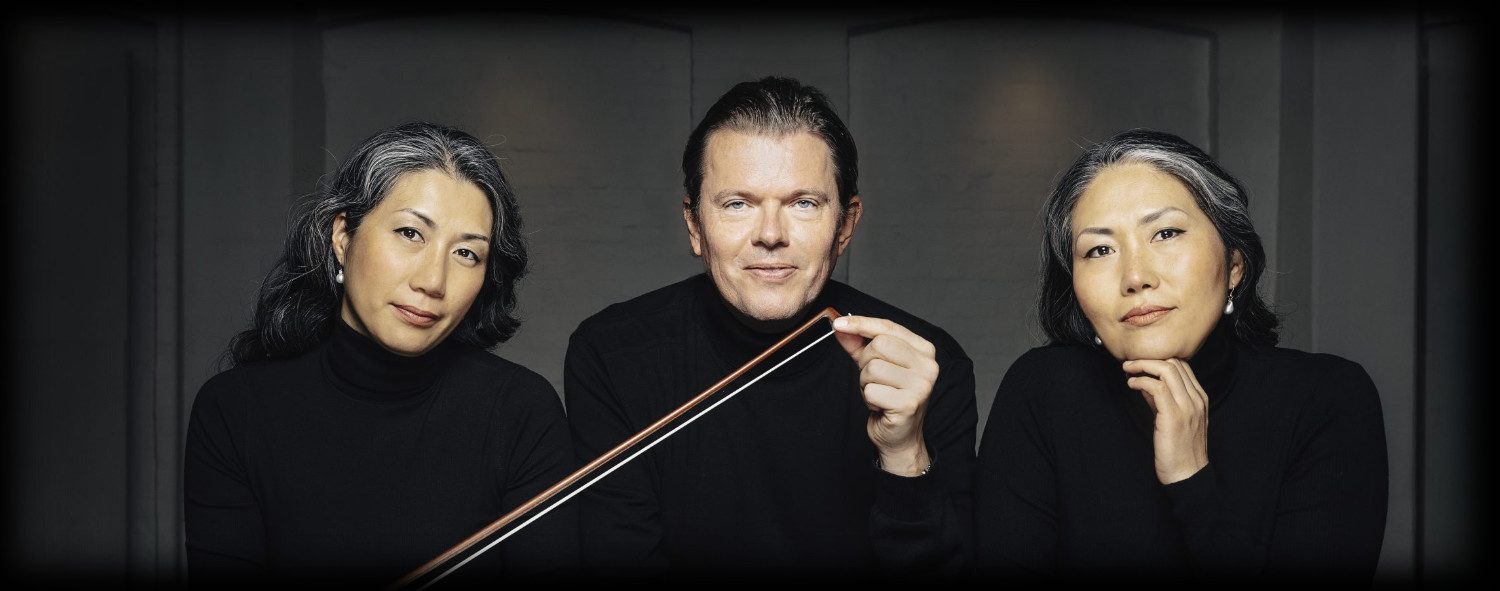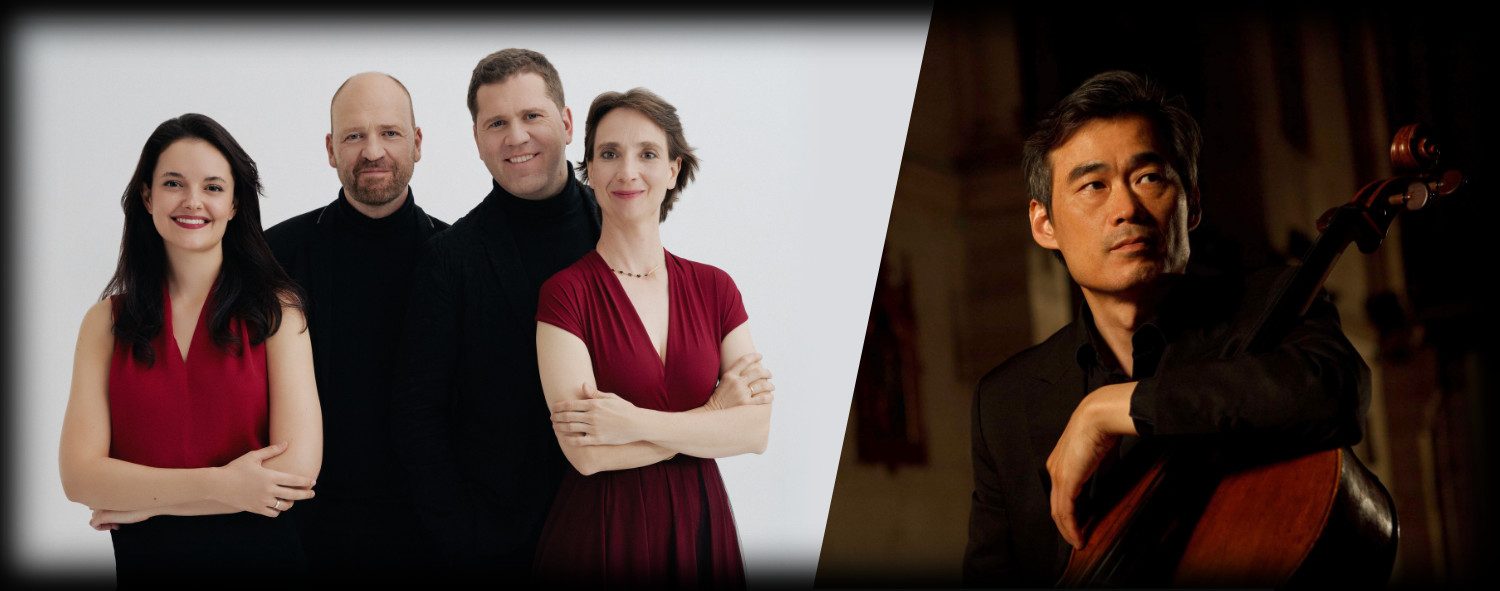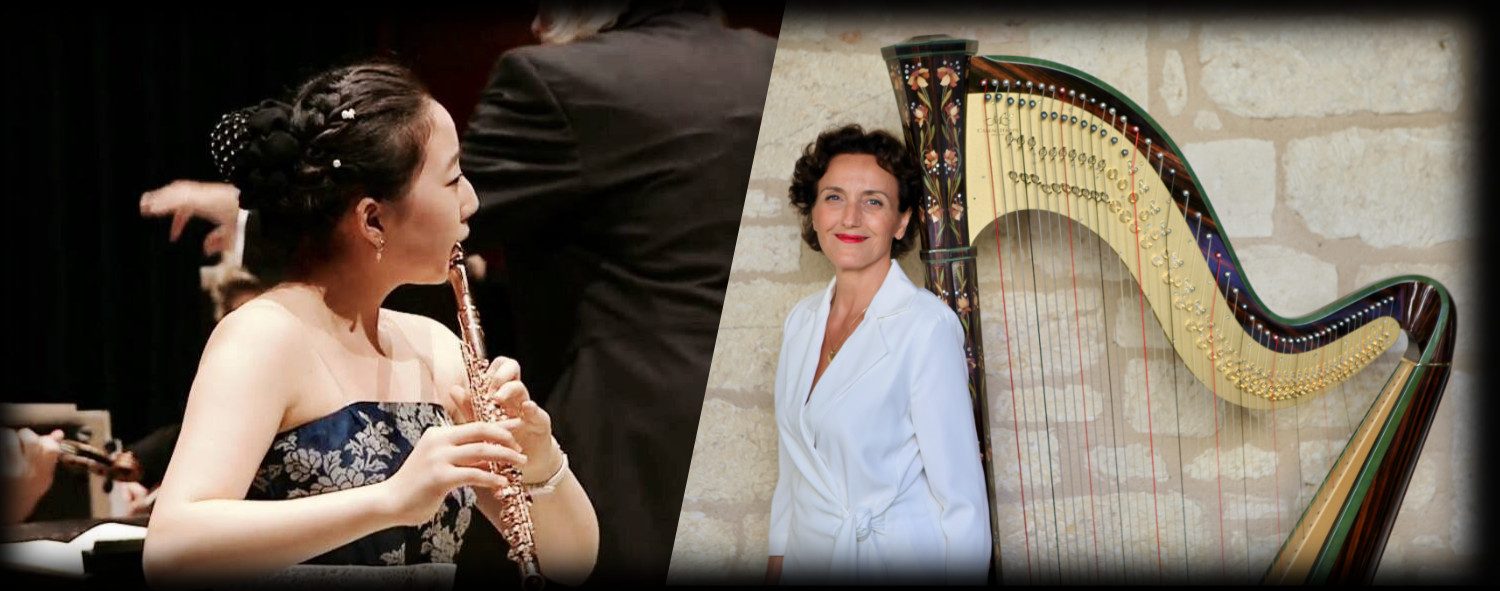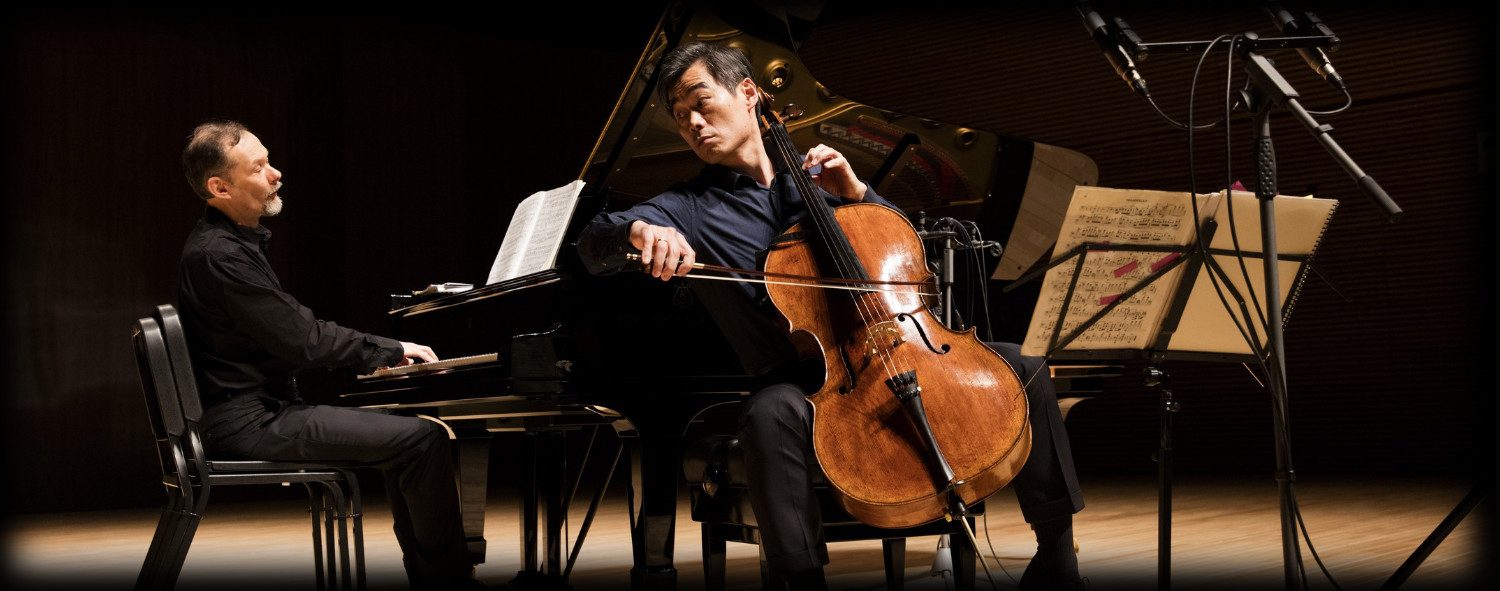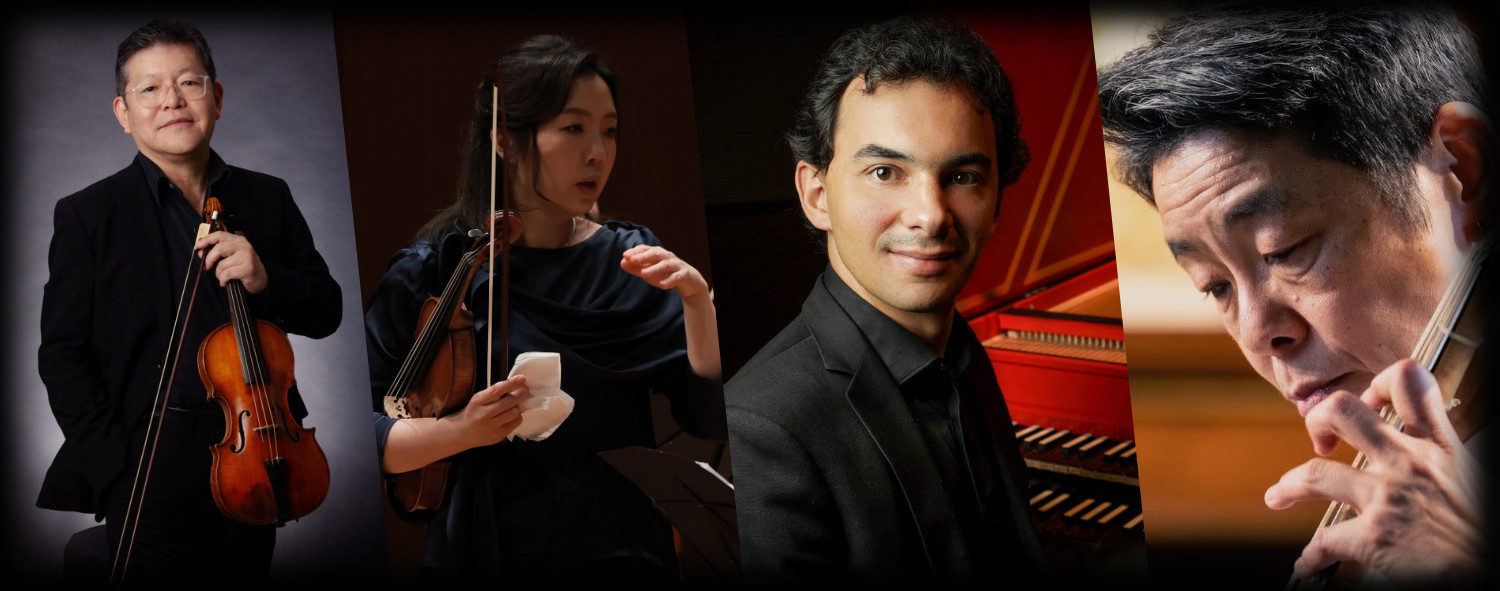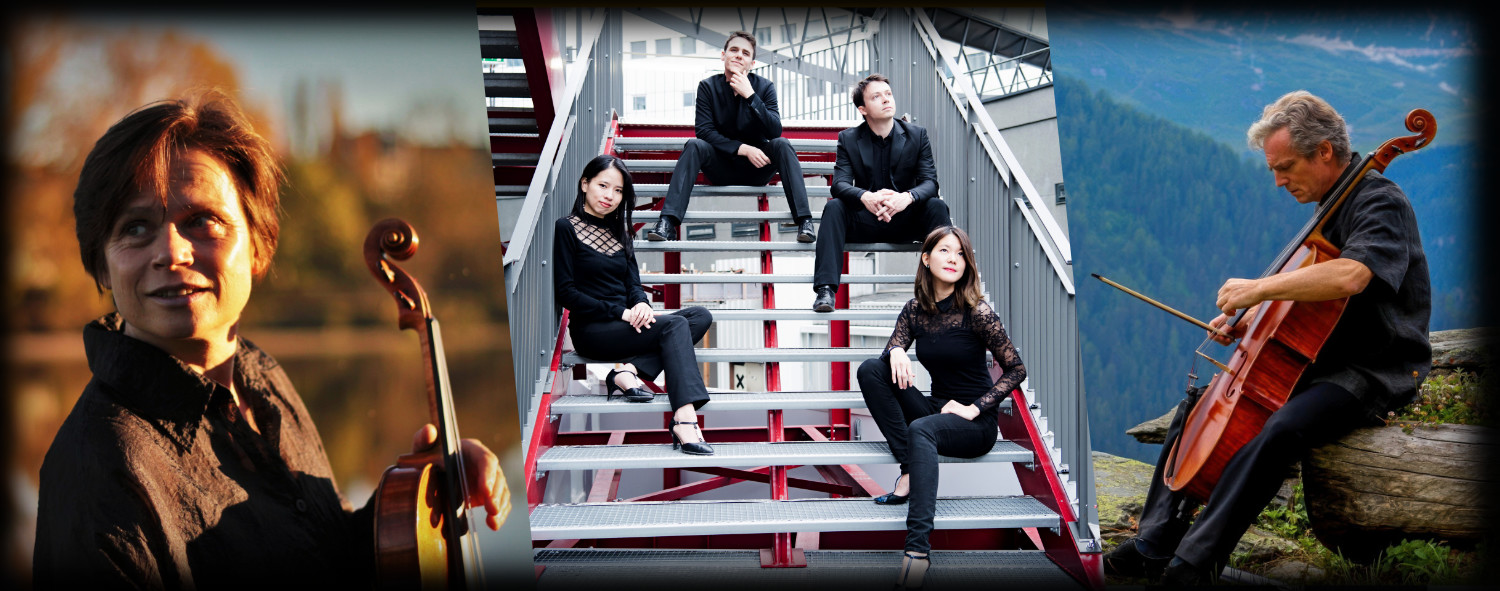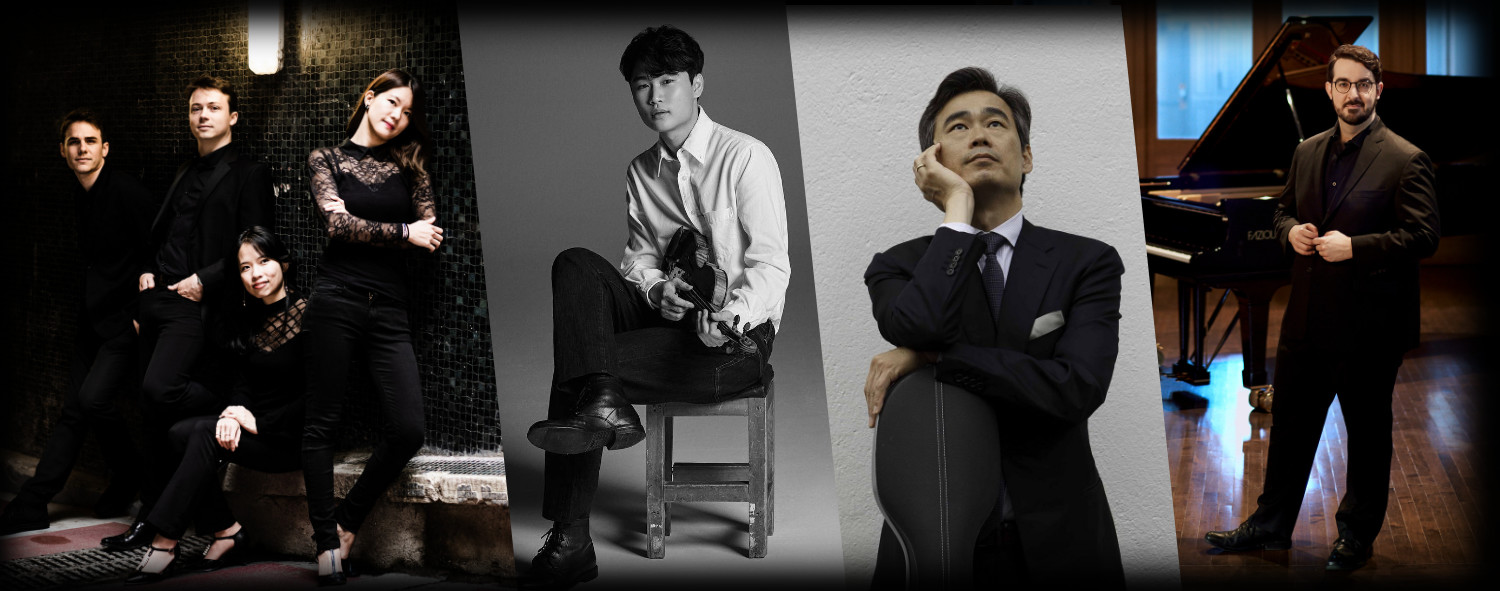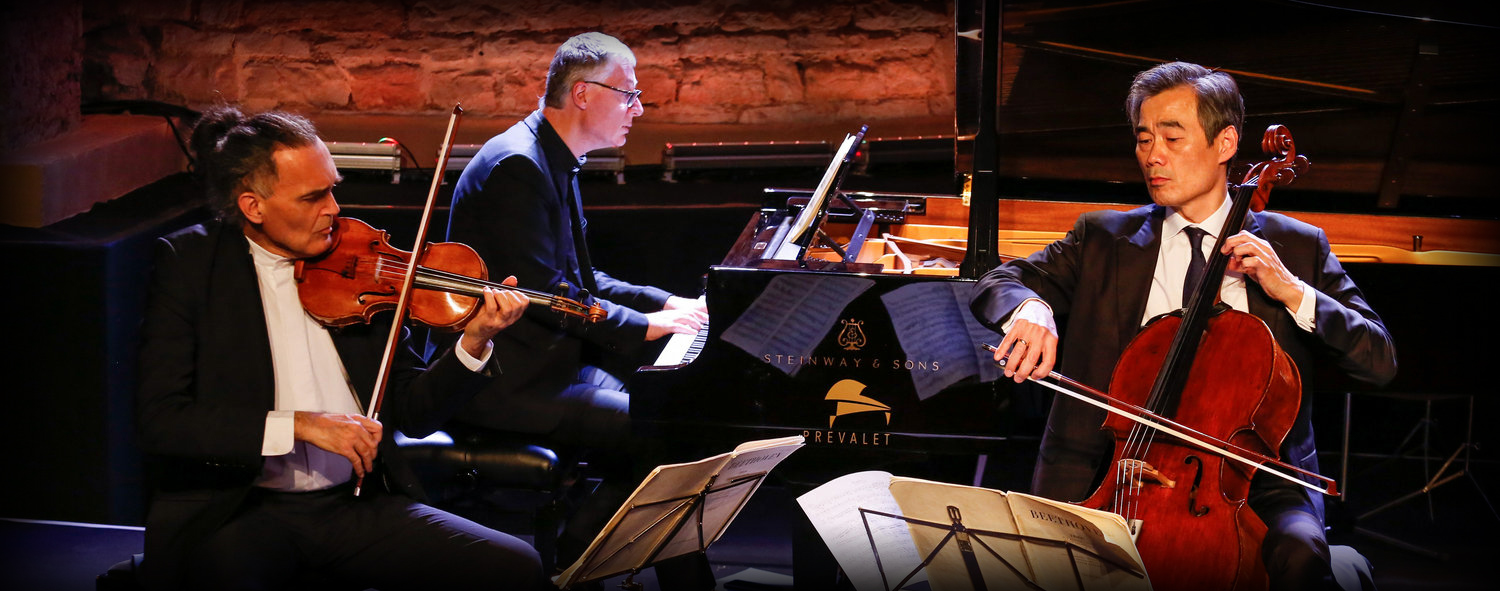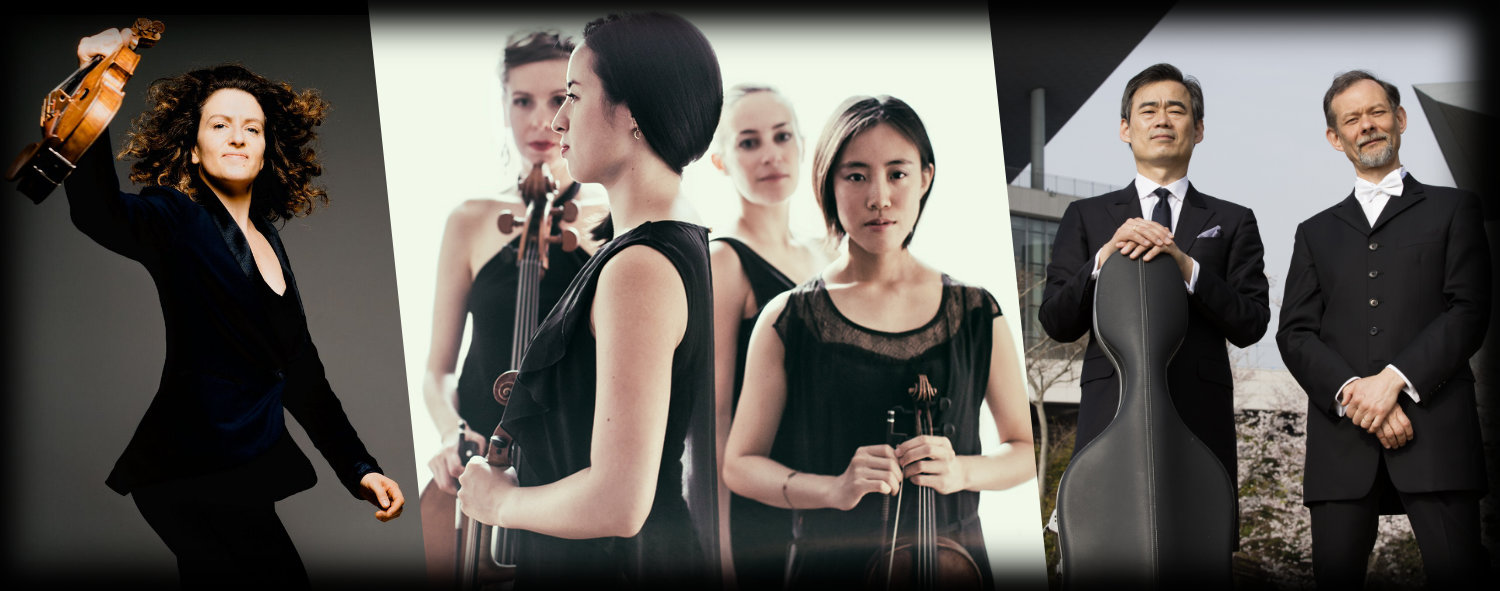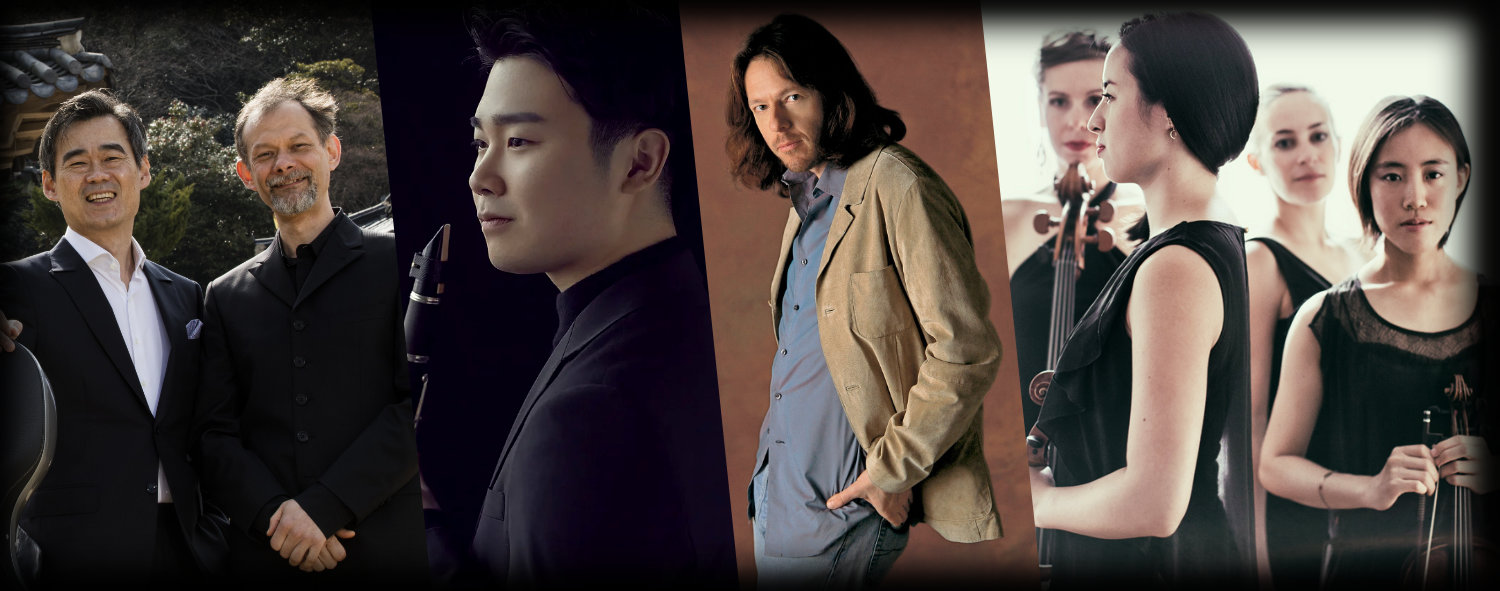Program
Thursday, April 23 – 20h : La Lanterne Magique, Beaune
Piano Trio Evening
Bent Sørensen (b. 1958)
Masquerade for piano trio (2023) – French premiere
Commissioned by Pierre Boulez Saal, Music in PyeongChang, Aulaserierne, and Hindsgavl Festival
- Prelude
- Barcarolle
- Waltz
- Chorale
- Rhumba
Ludwig van Beethoven (1770–1827)
Piano Trio in E-flat major, Op. 1 No. 1
- Allegro
- Adagio cantabile
- Scherzo. Allegro assai – Trio
- Finale. Presto
Intermission
Piotr Ilitch Tchaïkovski (1840–1893)
Piano Trio in A minor, Op. 50 « À la mémoire d’un grand artiste »
- Pezzo elegiaco. Moderato assai – Allegro giusto
- Tema con variazioni. Andante con moto –
Variazione finale e coda. Allegro risoluto e con fuoco – Andante con moto
Friday, April 24 – 20h : La Lanterne Magique, Beaune
Beethoven & Schubert
Cuarteto Casals
Sung-Won Yang, cello
Ludwig van Beethoven (1770–1827)
String Quartet No. 13 in B-flat major, Op. 130
- Adagio, ma non troppo – Allegro
- Presto
- Andante con moto, ma non troppo
- Alla danza tedesca. Allegro assai
- Cavatina. Adagio molto espressivo
Ludwig van Beethoven (1770–1827)
Grosse Fugue in B-flat major, Op. 133
Intermission
Franz Schubert (1797–1828)
String Quintet in C major, D. 956
- Allegro ma non troppo
- Adagio
- Scherzo. Presto – Trio. Andante sostenuto
- Allegretto
Saturday, April 25 – 20h : La Lanterne Magique, Beaune
Flute & Harp
Isabelle Moretti, harp
Yaeram Park, flute
Claude Debussy (1862–1918)
Suite bergamasque (arr. Juliette Hurel & Isabelle Moretti, for flute and harp)
- Prélude
- Menuet
- Clair de lune
- Passepied
Clémence de Grandval (1828–1907)
Valse mélancolique (flute and harp)
Gabriel Fauré (1845–1924)
Sicilienne, Op. 78 (flute and harp)
Jean Cras (1879–1932)
Suite en duo (flute and harp)
- Préambule. Modéré
- Modéré
- Assez lent
- Danse à onze temps. Très animé
Intermission
Camille Saint-Saëns (1835–1921)
Fantaisie in A major, Op. 124 (flute and harp)
Georges Bizet (1838–1875)
Entr’acte from Carmen (flute and harp)
Claude Debussy (1862–1918)
Deux Arabesques (solo harp)
- Première arabesque
- Deuxième arabesque
Gabriel Fauré (1845–1924)
Clair de lune (flute and harp)
Astor Piazzolla (1921–1992)
Histoire du Tango (flute and harp)
- Bordel 1900
- Café 1930
- Nightclub 1960
Sunday 26 Avril – 16h30 : Salle St Nicolas, Hospices de Beaune
Bach, Montalbetti & Brahms
Enrico Pace, piano
Sung-Won Yang, cello
Johann Sebastian Bach (1685–1750)
Sonata for viola da gamba and harpsichord in G major, BWV 1027
- Adagio
- Allegro ma non tanto
- Andante
- Allegro moderato
Johannes Brahms (1833–1897)
Sonata for cello and piano No. 2 in F major, Op. 99
- Allegro vivace
- Adagio affettuoso
- Allegro passionato
- Allegro molto
Entracte
Eric Montalbetti (né en 1968)
Trios impromptus – world premiere
Johannes Brahms (1833–1897)
Sonata for cello and piano No. 1 in E minor, Op. 38
- Allegro non troppo
- Allegretto quasi Menuetto
- Allegro
Thursday 3 April – 20h : Salle St Nicolas, Hospices de Beaune
Ryo Terakado, EunShik Kim, Kaori Uemura, François Guerrier
Ryo Terakado, baroque Violin
EunShik Kim, baroque Violin
Kaori Uemura, Viol
François Guerrier, Harpsichord
François Couperin (1668-1733)
L’Impériale, sonade (Les Nations, 1726)
Gravement – Vivement – Gravement et marqué – Légèrement – Rondement – Vivement
Louis Couperin (1626-1661)
Pièces en ut : Prélude – Sarabande – Passacaille
François Couperin
Le Parnasse, ou l’Apothéose de Corelli, grande sonade en trio (Les Goûts réunis, 1724)
Carl Philipp Emanuel Bach (1714-1788)
Sonate en do mineur “Sanguineus und Melancholicus”, Wq 161 (1749)
Allegretto/Presto – Adagio – Allegro
Johann Sebastian Bach (1685-1750)
Sonate en Sol Majeur BWV 530 (arr. de la 6ème sonate pour orgue)
Vivace – Lento – Allegro
Friday, April 4th – 20h : La Lanterne Magique, Beaune
Quatuor Hermès with Eric and Hélène Levionnois
Buy tickets
Quatuor Hermès
Eric Levionnois, cello
Hélène Levionnois, viola
Fanny Mendelssohn
Quatuor à cordes en Mi bémol
Felix Mendelssohn
Quatuor à cordes Op. 12, en Mi bémol majeur
Johannes Brahms
Sextuor à cordes No. 2 en Sol Majeur Op. 36
Saturday, April 5th – 20h : La Lanterne Magique, Beaune
Quatuor Hermès, Inmo Yang, Charles Richard-Hamelin, Sung-Won Yang
Buy tickets
Inmo Yang, violin
Charles Richard-Hamelin, piano
Sung-Won Yang, cello
Quatuor Hermès
Clara Schumann
Trio avec Piano, en sol mineur Op. 17 (avec Sung-Won Yang)
Robert Schumann
Sonate pour violon et piano en ré mineur Op. 121
Chausson
Concert pour Violon, Piano et Quatuor à cordes Op. 21 (avec le Quatuor Hermès)
Sunday, April 6th – 16h30 : La Lanterne Magique, Beaune
Trio Owon
Buy tickets
Trio Owon
Olivier Charlier, violin
Sung-Won Yang, cello
Emmanuel Strosser, piano
Felix Mendelssohn
- Variations concertantes pour violoncelle et piano en Ré Majeur Op. 17
- trio avec piano, violon et violoncelle en ré mineur Op. 49
Fanny Mendelssohn
- Adagio pour violon et piano
Felix Mendelssohn
- trio avec piano, violon et violoncelle en do mineur Op. 66
Thursday, April 4th – 20h : La lanterne magique, Beaune
Liza Ferschtman, Enrico Pace, Sung-Won Yang, Quatuor Ardeo
Schubert, Sonate pour violon et piano en La Majeur D. 574
Liza Ferschtman, violin
Enrico Pace, piano
Franz Schubert made some momentous decisions prior to composing his fourth and final violin sonata in August 1817. He decided not to return to teaching at his father’s school and he left the family home to move in with his friend, poet and future librettist, Franz von Schober. Originally entitled sonata for piano and violin – the order of instruments is telling – D. 574 represents a grander ambition and requires greater virtuosity than his previous ‘sonatinas’, as was reflected in Diabelli’s decision to posthumously publish it as ‘Grand Duo’ for violin and piano.
The Sonata for violin and piano in A major D. 574, begins in conventional fashion with a sonata-form Allegro moderato. However, Schubert replaces the expected minuet with a fiery Scherzo: presto which flies through far-flung harmonies, before sidling into a central Trio. The Andantino begins with a beguiling melody interrupted by dramatic outbursts. The finale, an Allegro vivace travels through three keys rather than the conventional two in its exposition; something that becomes a fingerprint of Schubert’s sonata forms. In 1825, Schubert adapted its second subject as a dance, his Cotillon in E flat major, D. 976.
Beethoven, Trio pour Piano, Violon, et Violoncelle en Ré Majeur Op. 70 No. 1 ‘Les Esprits’
Enrico Pace, piano
Liza Ferschtman, violin
Sung-Won Yang, cello
In 1808, Ludwig van Beethoven was considering writing an opera after Macbeth. Amid the abandoned sketches for that work are ideas for what became the slow movement of his Piano Trio, Op. 70 no. 1, completed the following year. Carl Czerny later made a connection between the Largo assai ed espressivo and another Shakespeare play, hearing in its tremolandi and chromaticisms an evocation of the scene where Hamlet meets his father’s ghost. Hence the nickname of a piano trio written during a summer spent at Countess Marie von Erdödy’s estate in Heiligenstadt.
The outer movements of Op. 70 no. 1 have a brighter outlook than the trio’s spectral centre. The unison opening of the Allegro vivace e con brio breaks off unexpectedly, the cello introducing a theme that, in an 1813 review, E.T.A. Hoffmann described the second theme as ‘expressing a genial serenity, a cheerful, confident awareness of its own strength and substance.’ The fluctuating moods of the final Presto rondo continue to explore unusual harmonies, continuing the playfully questioning of the first movement, before ending with an exuberant coda.
intermission
L. Janáček, 2ème Quatuor à Cordes “Lettre Intime”
Quatuor Ardeo
In 1923, the Bohemian Quartet asked Janáček to compose two works for them. The first, known as the ‘Kreutzer Sonata’ after Leo Tolstoy’s novella, was completed quite quickly and given its premiere on 17 October 1924. The second took longer and was eventually performed by the Moravian Quartet on 11 September 1928, weeks after Janáček’s death.
The composer had met Kamila Stösslová in 1917 and immediately became besotted. She was forty years his junior and married with children, but this did not stop the composer sending her more than 650 letters. Their first kiss, on 19 August 1927, apparently inspired the quartet, originally entitled ‘Love Letters’. While Janáček devised a programme for the piece it was not included in the published score and the title was changed to the less provocative Listy důvěrné (‘Intimate Letters’). Of course this has not stopped critics and scholars speculating about how dialogues between the instruments of the quartet – their contrasting themes and harmonies – might reflect the different stages of their relationship: from first hope to final joy.
Friday, April 5th – 20h : La Lanterne Magique, Beaune
Sung-Won Yang, Enrico Pace, Frank Braley, Han Kim, Quatuor Ardeo
Janáček, Pohádka, a tale for cello and piano
Sung-Won Yang, cello
Enrico Pace, piano
“Pohádka” (“A Tale”) is a captivating piece for cello and piano composed by the Czech composer Leoš Janáček. Written in 1910, the work is inspired by the Russian fairy tales of Vasily Zhukovsky. It consists of three movements, each depicting a different fairy tale character or scene. The piece is characterized by its lyrical melodies, folk-inspired rhythms, and rich harmonic language, showcasing Janáček’s distinctive musical voice. “Pohádka” is a beautiful and evocative work that transports the listener to a world of enchantment and wonder, for cello and piano.
- Con moto – andante
- Con moto – adagio
- Allegro
Brahms, Trio pour piano, clarinette et violoncelle en La mineur Op. 114
Frank Braley, piano
Han Kim, clarinet
Sung-Won Yang, cello
Brahms first heard the clarinettist Richard Mühlfeld while visiting Meiningen in March 1891. So taken was he with Mühlfeld’s beautiful, vibrato-rich playing in Mozart’s Clarinet Quintet and various orchestral works he retracted his declaration to have stopped composing and produced a Clarinet Trio and Clarinet Quintet (Clarinet Sonatas followed a few years later). Both Trio and Quintet were performed privately in Meiningen on 24 November 1891, with Brahms at the piano and Joseph Joachim’s quartet; the first public took place in Berlin on 12 December.
Brahms apparently preferred the more enigmatic Trio to the popular Quintet. The first movement pulls between its opening lyrical melody, introduced by cello and clarinet, and most tempestuous figuration. The harmonies constantly turn away from major to minor until the end of the movement which alights on A major, leading to the D major of the fulsome Adagio. While the third movement might be a scherzo it is gentle in tone and tempo, marked Andantino grazioso. The minor mode returns, inescapably, in the final Allegro.
intermission
Dvorák, Quintette No. 2 pour piano et quatuor à cordes en La Majeur Op. 81
Frank Braley, piano
Quatuor Ardeo
Chamber music was central to Antonín Dvořák’s output, from his first compositions in the 1860s to the end of his career, perhaps reflecting that he was a viola player. One of the only breaks in production was in the mid-1880s, when he concentrated for a few years on commissions for Brahms’s publisher, Simrock. After that he composed some small-scale character works – a Terzetto, Drobnosti (Miniatures), and an arrangement of part of his song cycle Cypresses for string quartet as Echo of Songs. But then, he composed one of his most celebrated works, the second piano quintet in A major, op. 81, first performed in Prague on 6 January 1888. The four movements demonstrate the melodic beauty, rhythmic vitality, and formal clarity of Dvořák’s mature style: from the leisurely theme that starts the Allegro, ma non tanto, to the characteristically ‘furiant’ Scherzo; through to the contrapuntal elan of the finale. The second movement, ‘Dumka’, predates Dvořák’s Piano Trio op.90 the ‘Dumky’ by two years. The composer was particularly associated with this Slavonic genre typically featuring a slow and melancholy melody with contrasting sections that owe something to folk music.
